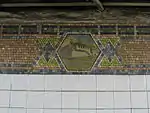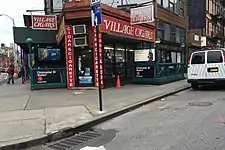Christopher Street–Sheridan Square station
The Christopher Street–Sheridan Square station is a local station on the IRT Broadway–Seventh Avenue Line of the New York City Subway. Located at the intersection of Christopher Street and Seventh Avenue South in Manhattan, it is served by the 1 train at all times and by the 2 train during late nights.
Christopher Street– Sheridan Square | ||||||||||||||||||||||||||||||||||||||||||||||||||||||||||||||||||||
|---|---|---|---|---|---|---|---|---|---|---|---|---|---|---|---|---|---|---|---|---|---|---|---|---|---|---|---|---|---|---|---|---|---|---|---|---|---|---|---|---|---|---|---|---|---|---|---|---|---|---|---|---|---|---|---|---|---|---|---|---|---|---|---|---|---|---|---|---|
 Northbound 1 train departs | ||||||||||||||||||||||||||||||||||||||||||||||||||||||||||||||||||||
| Station statistics | ||||||||||||||||||||||||||||||||||||||||||||||||||||||||||||||||||||
| Address | Christopher Street & Seventh Avenue South New York, NY 10014 | |||||||||||||||||||||||||||||||||||||||||||||||||||||||||||||||||||
| Borough | Manhattan | |||||||||||||||||||||||||||||||||||||||||||||||||||||||||||||||||||
| Locale | Greenwich Village | |||||||||||||||||||||||||||||||||||||||||||||||||||||||||||||||||||
| Coordinates | 40.733°N 74.003°W | |||||||||||||||||||||||||||||||||||||||||||||||||||||||||||||||||||
| Division | A (IRT)[1] | |||||||||||||||||||||||||||||||||||||||||||||||||||||||||||||||||||
| Line | IRT Broadway–Seventh Avenue Line | |||||||||||||||||||||||||||||||||||||||||||||||||||||||||||||||||||
| Services | 1 2 | |||||||||||||||||||||||||||||||||||||||||||||||||||||||||||||||||||
| Transit | ||||||||||||||||||||||||||||||||||||||||||||||||||||||||||||||||||||
| Structure | Underground | |||||||||||||||||||||||||||||||||||||||||||||||||||||||||||||||||||
| Platforms | 2 side platforms | |||||||||||||||||||||||||||||||||||||||||||||||||||||||||||||||||||
| Tracks | 4 | |||||||||||||||||||||||||||||||||||||||||||||||||||||||||||||||||||
| Other information | ||||||||||||||||||||||||||||||||||||||||||||||||||||||||||||||||||||
| Opened | July 1, 1918 | |||||||||||||||||||||||||||||||||||||||||||||||||||||||||||||||||||
| Opposite- direction transfer | No | |||||||||||||||||||||||||||||||||||||||||||||||||||||||||||||||||||
| Traffic | ||||||||||||||||||||||||||||||||||||||||||||||||||||||||||||||||||||
| 2019 | 3,412,332[2] | |||||||||||||||||||||||||||||||||||||||||||||||||||||||||||||||||||
| Rank | 146 out of 424[2] | |||||||||||||||||||||||||||||||||||||||||||||||||||||||||||||||||||
| ||||||||||||||||||||||||||||||||||||||||||||||||||||||||||||||||||||
| ||||||||||||||||||||||||||||||||||||||||||||||||||||||||||||||||||||
| ||||||||||||||||||||||||||||||||||||||||||||||||||||||||||||||||||||
| ||||||||||||||||||||||||||||||||||||||||||||||||||||||||||||||||||||
| ||||||||||||||||||||||||||||||||||||||||||||||||||||||||||||||||||||
The station was built by the Interborough Rapid Transit Company (IRT) as part of the Dual Contracts with New York City, and opened on July 1, 1918. The station had its platforms extended in the 1960s, and was renovated in 1991-1994.
History
Construction and opening


The Dual Contracts, which were signed on March 19, 1913, were contracts for the construction and/or rehabilitation and operation of rapid transit lines in the City of New York. The contracts were "dual" in that they were signed between the City and two separate private companies (the Interborough Rapid Transit Company and the Brooklyn Rapid Transit Company), all working together to make the construction of the Dual Contracts possible. The Dual Contracts promised the construction of several lines in Brooklyn. As part of Contract 4, the IRT agreed to build a branch of the original subway line south down Seventh Avenue, Varick Street, and West Broadway to serve the West Side of Manhattan.[3][4][5]
The construction of this line, in conjunction with the construction of the Lexington Avenue Line, would change the operations of the IRT system. Instead of having trains go via Broadway, turning onto 42nd Street, before finally turning onto Park Avenue, there would be two trunk lines connected by the 42nd Street Shuttle. The system would be changed from looking like a "Z" system on a map to an "H" system. One trunk would run via the new Lexington Avenue Line down Park Avenue, and the other trunk would run via the new Seventh Avenue Line up Broadway. In order for the line to continue down Varick Street and West Broadway, these streets needed to be widened, and two new streets were built, the Seventh Avenue Extension and the Varick Street Extension.[6] It was predicted that the subway extension would lead to the growth of the Lower West Side, and to neighborhoods such as Chelsea and Greenwich Village.[7][8]
In August 1917, the Greenwich Village Public Service Committee requested that the New York Public Service Commission rename the station from Christopher Street to Christopher Street—Sheridan Square. The Public Service Commission voted to make the change on August 20, 1917.[9]
Christopher Street–Sheridan Square opened as part of an extension of the line from 34th Street–Penn Station to South Ferry on July 1, 1918.[10][11] Initially, the station was served by a shuttle running from Times Square to South Ferry.[12][13] The new "H" system was implemented on August 1, 1918, joining the two halves of the Broadway–Seventh Avenue Line and sending all West Side trains south from Times Square.[14] An immediate result of the switch was the need to transfer using the 42nd Street Shuttle in order to retrace the original layout. The completion of the "H" system doubled the capacity of the IRT system.[7]
Later years
The city government took over the IRT's operations on June 12, 1940.[15][16] On August 9, 1964, the New York City Transit Authority (NYCTA) announced the letting of a $7.6 million contract to lengthen platforms at stations on the Broadway—Seventh Avenue Line from Rector Street to 34th Street–Penn Station, including Christopher Street, and stations from Central Park North–110th Street to 145th Street on the Lenox Avenue Line to allow express trains to be lengthened from nine-car trains to ten-car trains, and to lengthen locals from eight-car trains to ten-car trains. With the completion of this project, the NYCTA project to lengthen IRT stations to accommodate ten-car trains would be complete.[17]
In 1981, the Metropolitan Transportation Authority listed the station among the 69 most deteriorated stations in the subway system.[18]
The station was renovated by in-house forces in 1994.
Station layout
.jpg.webp)

| Ground | Street level | Exit/entrance |
| Platform level | Side platform | |
| Northbound local | ← ← | |
| Northbound express | ← | |
| Southbound express | | |
| Southbound local | | |
| Side platform | ||
This underground station has two side platforms and four tracks. The station is served by the 1 at all times[19] and by the 2 during late nights;[20] the center express tracks are used by the 2 and 3 trains during daytime hours.[20][21] The station is between 14th Street to the north and Houston Street to the south.[22]
Both platforms have the standard IRT trim line and mosaic name tablets reading "CHRISTOPHER ST. SHERIDAN SQ." on two lines. The columns are painted dark green with every other one having the standard black station name plate with white lettering. There are also signs directing to New York University.
The station features a site specific artwork, entitled Greenwich Village Murals, created in 1994 by Lower East Side artist, Lee Brozgol and the students of Public School 41. It features twelve mosaic frame panels on the platform walls depicting the history of Greenwich Village. The names of some of these panels include "Bohemians", "Rebels", "Founders", and "Providers".
Exits
Each platform has one fare control area at the center containing a turnstile bank and token booth. There is no free transfer between directions. The South Ferry-bound fare control has four street stairs to the diagonal intersection of Christopher Street and Seventh Avenue: two to the northwestern corner and two to the southwestern one. The Bronx-bound fare control has a single staircase to the island formed by Seventh Avenue, West Fourth Street, and Grove Street.[23]
Nearby points of interest
The Stonewall National Monument, encompassing Christopher Park and the Stonewall Inn, is across West Fourth Street from the Bronx-bound entrance.[23]
The Hess triangle, a small triangular-shaped plaque in the sidewalk with one 65-centimeter (26 in) side and two 70-centimeter (28 in) sides, is located outside the South Ferry-bound entrances at the southwest corner of Christopher Street and Seventh Avenue South.[23]
In popular culture
In Bright Lights, Big City (1988), Michael J. Fox is seen jumping the turnstiles and then boarding a train at the station while running away from his brother.
In season 2, episode 5 of Friends (1995), filmed during the renovations of the station, the south entrance of the station is depicted as being closed.
The station can briefly be seen in the backdrop of the music video for David Bowie's "I'm Afraid of Americans" (1997).
The 1999 comedy movie Big Daddy includes a scene of Adam Sandler, his character's foster son, and friends outside this station.
The Steely Dan song Pixeleen from the Everything Must Go album, released in 2003, alludes to the subway station.
References
- "Glossary". Second Avenue Subway Supplemental Draft Environmental Impact Statement (SDEIS) (PDF). Vol. 1. Metropolitan Transportation Authority. March 4, 2003. pp. 1–2. Archived from the original (PDF) on February 26, 2021. Retrieved January 1, 2021.
- "Facts and Figures: Annual Subway Ridership 2014–2019". Metropolitan Transportation Authority. 2020. Retrieved May 26, 2020.
- "Terms and Conditions of Dual System Contracts". nycsubway.org. Public Service Commission. March 19, 1913. Archived from the original on May 13, 2015. Retrieved February 16, 2015.
- "The Dual System of Rapid Transit (1912)". nycsubway.org. Public Service Commission. September 1912. Archived from the original on January 26, 2021. Retrieved May 30, 2017.
- "Most Recent Map of the Dual Subway System Which Shows How Brooklyn Borough Is Favored In New Transit Lines". The Brooklyn Daily Eagle. September 9, 1917. p. 37. Archived from the original on October 26, 2016. Retrieved August 23, 2016 – via Brooklyn Public Library; newspapers.com.
- Engineering News-record. McGraw-Hill Publishing Company. 1916. Archived from the original on 2022-05-04. Retrieved 2020-12-09.
- Whitney, Travis H. (March 10, 1918). "The Seventh and Lexington Avenue Subways Will Revive Dormant Sections" (PDF). The New York Times. p. 12. ISSN 0362-4331. Archived (PDF) from the original on December 12, 2019. Retrieved August 26, 2016.
- "Public Service Commission Fixes July 15 For Opening of The New Seventh and Lexington Avenue Subway Lines" (PDF). The New York Times. May 19, 1918. p. 32. ISSN 0362-4331. Archived (PDF) from the original on July 13, 2021. Retrieved November 6, 2016.
- Report of the Public Service Commission For The First District of the State of New York For The Year Ending December 31, 1917 Vol. I. New York State Public Service Commission. 1918. p. 178. Archived from the original on March 13, 2022. Retrieved November 28, 2021.
- "7th Avenue Subway System Is Opened To Public To-day: First Train Will Start at 2 O'Clock This Afternoon". New-York Tribune. 1 Jul 1918. p. 9. ProQuest 575909557.
- "Open New Subway to Regular Traffic" (PDF). The New York Times. July 2, 1918. p. 11. ISSN 0362-4331. Archived (PDF) from the original on May 30, 2020. Retrieved November 6, 2016.
- "7th Avenue Subway System Is Opened To Public To-day: First Train Will Start at 2 O'Clock This Afternoon". New-York Tribune. 1 Jul 1918. p. 9. ProQuest 575909557.
- "Times Sq. Grows as Subway Centre: New Seventh Avenue Line, Open Today, Marks Great Transportation Advance". The New York Times. 1917-07-01. p. RE11. ISSN 0362-4331. ProQuest 99994412. Retrieved 2022-11-22.
- "Open New Subway Lines to Traffic; Called a Triumph" (PDF). The New York Times. August 2, 1918. p. 1. ISSN 0362-4331. Archived (PDF) from the original on 2021-02-21. Retrieved 2020-04-21.
- "City Transit Unity Is Now a Reality; Title to I.R.T. Lines Passes to Municipality, Ending 19-Year Campaign". The New York Times. 1940-06-13. ISSN 0362-4331. Archived from the original on January 7, 2022. Retrieved 2022-05-14.
- "Transit Unification Completed As City Takes Over I. R. T. Lines: Systems Come Under Single Control After Efforts Begun in 1921; Mayor Is Jubilant at City Hall Ceremony Recalling 1904 Celebration". New York Herald Tribune. June 13, 1940. p. 25. ProQuest 1248134780.
- "IRT Riders To Get More Train Room; $8.5 Million Is Allocated for Longer Stations and for 3 New Car Washers". The New York Times. August 10, 1964. ISSN 0362-4331. Archived from the original on January 10, 2021. Retrieved January 4, 2021.
- Gargan, Edward A. (June 11, 1981). "Agency Lists Its 69 Most Deteriorated Subway Stations". The New York Times. p. B5S. ISSN 0362-4331. Archived from the original on March 31, 2019. Retrieved August 13, 2016.
- "1 Subway Timetable, Effective August 12, 2023". Metropolitan Transportation Authority. Retrieved August 26, 2023.
- "2 Subway Timetable, Effective June 26, 2022". Metropolitan Transportation Authority. Retrieved August 26, 2023.
- "3 Subway Timetable, Effective June 26, 2022". Metropolitan Transportation Authority. Retrieved August 26, 2023.
- "Subway Map" (PDF). Metropolitan Transportation Authority. September 2021. Retrieved September 17, 2021.
- "MTA Neighborhood Maps: West Village" (PDF). mta.info. Metropolitan Transportation Authority. 2015. Archived (PDF) from the original on 24 July 2015. Retrieved 2 August 2015.
Further reading
External links
- nycsubway.org – IRT West Side Line: Christopher Street/Sheridan Square


